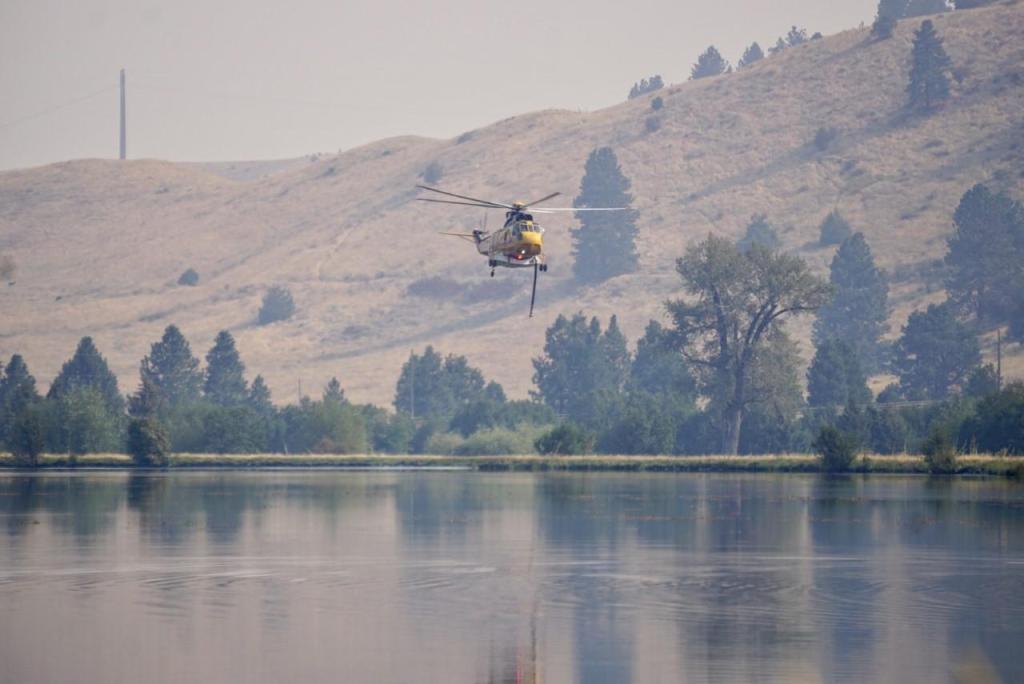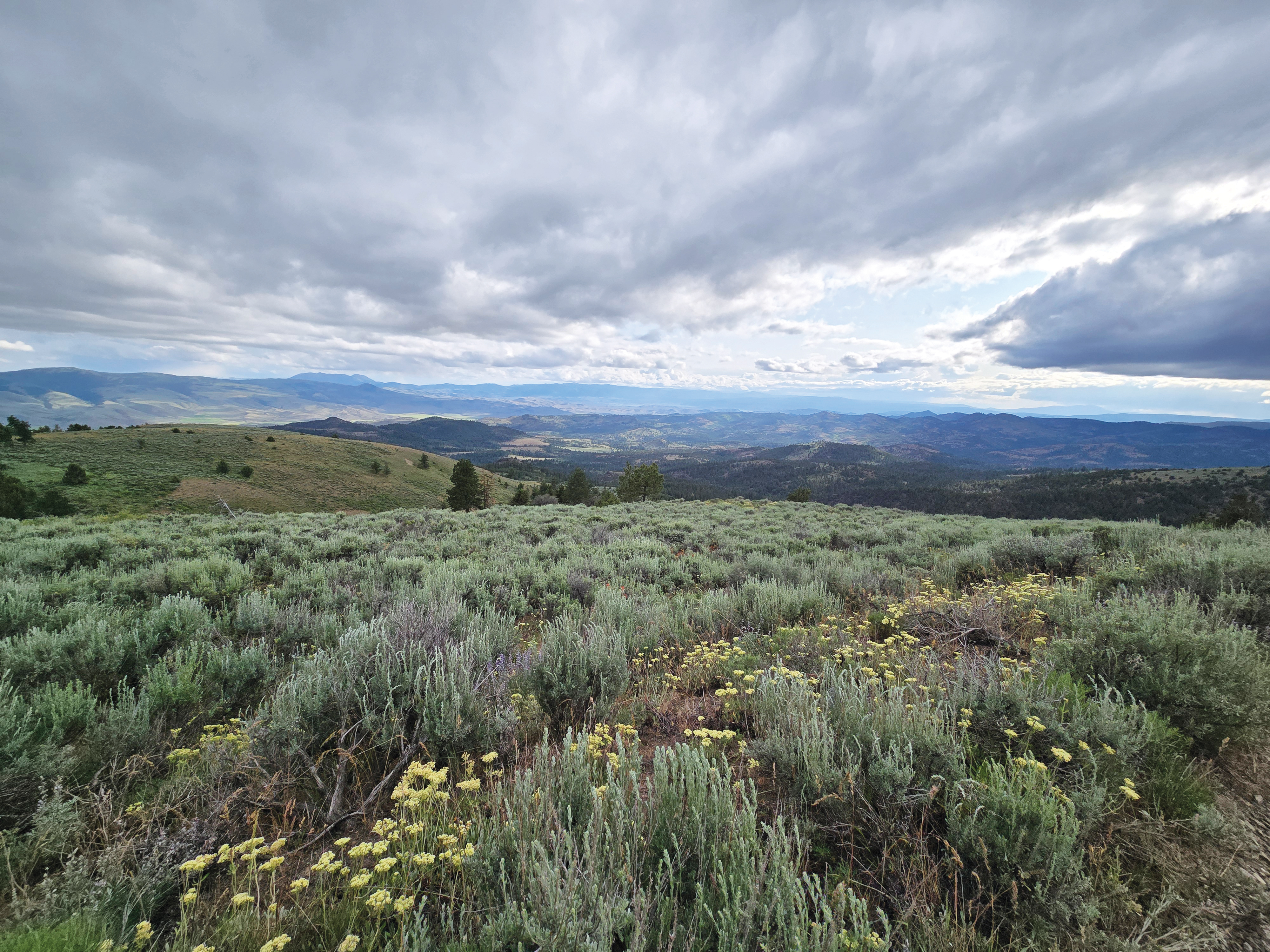Summer-like weather revives Eagle Cap Wilderness fires
Published 3:00 pm Friday, October 14, 2022

- A helicopter helping with the response to the Sturgill Fire hovers over Lostine Reservoir on Wednesday, Sept. 14, 2022.
BAKER CITY — Like the summer that refuses to go quietly, a couple wildfires in Wallowa County continue to act as though autumn isn’t nearly a month old.
The Sturgill Fire, started by lightning in the Eagle Cap Wilderness on Monday, Aug. 22, produced smoke visible from Baker and Union counties on Wednesday, Oct. 12.
And Todd Pederson expects that trend will continue for at least the next few days as a stubborn ridge of high pressure keeps skies clear and daytime temperatures about 15 degrees above average.
“The weather pattern seems to be pretty well set,” Pederson, an assistant fire management officer for the Wallowa-Whitman National Forest, said. “We’ve still got good burning conditions out there. I expect more activity and smoke the next couple days.”
The Sturgill Fire, which has burned about 21,000 acres in the Eagle Cap, Oregon’s biggest wilderness area at 365,000 acres, is behaving quite differently, though, than it did in late August and early September, Pederson said.
During that period the fire, fueled by temperatures in the 90s and strong winds on several days, spawned towering smoke plumes. On a couple days the fire generated a “pyrocumulus” cloud — basically, a fire-generated thunderhead.
With burning conditions much less severe than several weeks ago, Pederson said the fire is mainly creeping along the ground rather than torching entire trees as it did earlier.
In late August and early September, the fire burned intensely in some areas, killing swathes of trees, he said.
But this week the fire is acting basically like a prescribed blaze that officials ignite on purpose. The flames are benefiting the forest by consuming fuel on the ground, reducing the risk of a larger fire in the future, Pederson said.
“This is what we really want to see out of a prescribed fire program,” he said.
Indeed, letting lightning fires play their natural role is the purpose of a policy the Wallowa-Whitman has employed in the Eagle Cap Wilderness for more than 30 years.
When lightning sparked the Sturgill Fire and two other blazes in the wilderness in August — Goat Mountain 2, which is close to Sturgill, and Nebo, about 20 miles away at the eastern edge of the wilderness — Wallowa-Whitman officials mainly monitored the blazes rather than trying to put them out as soon as possible.
Firefighters did take action to limit the spread of the wilderness fires, including deploying helicopters to drop water and having firefighters on the ground build firebreaks.
The goals with the Sturgill Fire were to keep it from spreading into the Lostine River Canyon to the northwest, and to confine flames to the east side of the Minam River.
Pederson said the Wallowa-Whitman continues to meet both objectives.
He said no suppression work has been necessary with the fire this week given its much slower spread, nor does he expect any. However, two helicopters are available if needed.
Nebo and Double Creek fires
Crews did douse a small fire, less than one-tenth of an acre, last weekend on the part of the Nebo Fire that’s outside the Eagle Cap Wilderness.
Helicopters dropped water on the north end of another Wallowa County fire, the Double Creek blaze, as recently as Oct. 9, Pederson said.
The Double Creek Fire, started by lightning on Aug. 30 northeast of Joseph, is Oregon’s largest fire this year at about 171,000 acres.
Pederson said the Double Creek Fire remains within containment lines, but with the warm, dry weather over the past two weeks, flames have burned some islands of fuel inside the lines.
Fire season lasting longer than usual
The recent revival of the Wallowa County fires stems from what Pederson called an “abnormal” extension of the fire season.
A brief period of relatively cool weather, along with widespread rain, in mid-September stifled the blazes. But the persistent summer-like conditions since then have dried fuels and allowed residual heat in the fires to rekindle flames, Pederson said.
Burning indices — models that predict how fast a fire would spread — have risen well above average after dipping briefly below average in mid September.
Pederson said that based on historical records, there was about a 90% chance the fire season would end by Oct. 6.
This year is an outlier.
Still and all, the potential for significant fire growth remains quite low, Pederson said.
Although the weather remains dry and warm, the “burning window” — the period when conditions are most conducive to fire — is much smaller now than in the late summer, due to the shorter duration of intense sunlight, colder nights and higher humidities.
Pederson said the lack of strong winds under the stagnant high pressure ridge also greatly reduces the chance that the Sturgill, Double Creek or Nebo fires will become much more active than they’ve been this week.
Pederson said he took an airplane flight over the Sturgill Fire on Oct. 12, and he was pleased to see that new grass was already growing in some of the burned areas, nourished by the September rains.
He said other firefighters have seen bighorn sheep returning to the area as well.
“The weather pattern seems to be pretty well set. We’ve still got good burning conditions out there. I expect more activity and smoke the next couple days.”
— Todd Pederson, assistant fire management officer, Wallowa-Whitman National Forest






